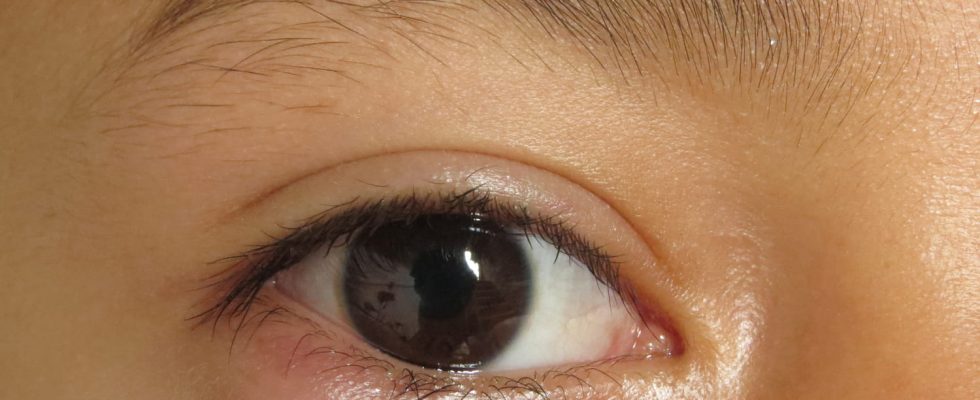We know the cellulite of the thighs, less that of the eye. However, it is necessary to know how to spot the signs of seriousness of this infection of the eyelid and the orbit because they can lead to hospitalization.
There cellulitis of the eye (also called “orbital cellulitis“) designates an inflammation of infectious origin of the tissues of the orbit. This infection can be consecutive to the propagation offacial infections adjacent like sinusitis where the ethmoiditis in children, to a skin infection or chalazion. Of course, cellulitis of the eye has nothing to do with cellulitis of the thighs and buttocks, giving the skin a padded appearance and Orange peel.
What is cellulitis of the eye?
“Ocular (or orbital) cellulitis is an inflammation of the soft tissues of infectious origin“, defines Laura Moyal from the outset, Ophthalmologist and oculopalpebral surgeon. It exists two forms of ocular cellulitis:
► Preseptal orbital cellulitis which affects superficial tissues, such as the skin and anterior muscles in the eyelids. It is the shape the most frequent. It is benign and responds well to drug treatments, with no risk of sequelae. It is manifested by swollen eyelids.
► Retroseptal orbital cellulitis (rarer) which can be very serious when the infection passes through the septum (the structure that delimits the anterior part of the posterior part of the orbit) and spreads behind the orbit. It can lead to loss of vision in the affected eye, or even death if it affects the vessels of the brain.
What are the causes of eye cellulitis?
“In 2/3 of cases, cellulitis of the eye is caused by an extension ofa sinus infection around the nose (nasal sinuses), ethmoid sinuses in children (ethmoiditis), maxillary sinuses (orbital cellulitis can spread from an infection of the teeth). In 1/3 of cases, cellulitis of the eye is caused by a skin infection, superinfection of a wound or the presence of a foreign body in the orbit. 90% of cases of cellulitis in the eye of children are of sinus origin“, explains our expert. A chalazion can evolve into cellulitis, but almost never in a serious form. The main aggravating factor for orbital cellulitis is takingnonsteroidal anti-inflammatory drugsespecially when given without antibiotics and self-medicated.
What are the symptoms of cellulitis of the eye?
Orbital cellulitis is clinically manifested by inflammatory signs as :
- swelling
- A redness
- A pain
- Sometimes fever
Pictures of an eye with orbital cellulitis
Is cellulite serious? What complications?
The most common form of cellulitis is the “preseptal” form which is, in the vast majority of cases, benign and responds favorably to drug treatment. Nevertheless, the appearance of the following signs of gravity requires hospitalization :
- A dilated pupil that no longer constricts in light (areactive mydriasis)
- A eye that can no longer move in all directions (oculomotor palsy/ophthalmoplegia)
- A loss of sight (even more alarming)
What is the treatment to cure cellulitis of the eye?
The treatment of ocular cellulitis is based on the administration of antibiotics:
► In case of preseptal cellulitis without signs of severity: oral antibiotic to be taken at home (outpatient) with monitoring of progress on D+2.
► In case of retroseptal cellulitis: the patient is hospitalized with the administration of antibiotic by venous way. Imaging is performed (scanner or orbital MRI) to check for tissue infiltration and to ensure that there is no abscess in the orbit or under the periosteum of the walls of the orbit.
► In case of cellulitis with complication (abscess…) or who responds poorly to intravenous antibiotic treatment: it is necessary to operate and carry out surgical drainage to eliminate pus and decompress the optic nerve to avoid the risk of loss of vision. But fortunately, it is very rare.
In any case the etiological treatment of the problem at the origin of the cellulitis must be carried out (often in collaboration with an ENT or dentist): drainage of a “blocked” sinus, dental treatment, debridement of a wound…
Thanks to Dr Laura Moyal, Ophthalmologist and Oculopalpebral Surgeon (specialized in cataract surgery and refractive surgery, cosmetic and functional eyelid surgery) at the Sorbonne Saint-Michel Ophthalmological Center in Paris (COSS) and also a practitioner at the 15-20 National Vision Hospital.

